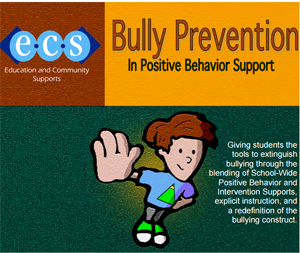You are here
Bullying Prevention - PBIS
Bullying Prevention - PBIS (BP-PBIS)

Description: School-wide approaches to bullying prevention have long been advocated for in the bullying literature. However, while many youth will benefit from general strategies, others may need additional support. One strategy that has gained prominence for a wide-range of behavior concerns is positive behavior interventions and supports (PBIS). Researchers have long argued for the use of PBIS as a way to reduce school-aged bullying concerns (see Swearer, Espelage, Love, & Kingsbury, 2008 for review and recommendations). Under this model, staff and other important stakeholders (e.g., parents, students) work to develop consistent expectations and guidelines for appropriate behaviors for students in all areas of the school, as well as to provide opportunities for students to learn and use these positive skills on an everyday-basis. By teaching and reinforcing these specific behaviors and peer interactions, staff work to increase positive and prosocial interactions while providing less social attention for negative or less appropriate behaviors. PBIS also requires that staff are provided with training and opportunities to best learn how to effectively respond to negative behaviors, such as bullying.
The Bullying Prevention- PBIS Program (BP-PBIS) is a whole-school bullying prevention program that is designed to be incorporated as part of a school’s comprehensive PBIS plan. The program seeks to teach students to differentiate between respectful and disrespectful behavior. By doing this, bullying behaviors are given less social attention while positive peer interaction is rewarded. The curriculum includes lessons that teach students how to respond to disrespectful behaviors (e.g., “Stop/Walk/Talk”). Subsequent lessons promote the use of these skills with other types of behaviors (e.g., gossip, inappropriate remarks, cyberbullying). The BP-PBIS program guide also addresses staff skill acquisition, such as learning to reward stop/walk/talk behavior and how to respond to student reports of bullying.
The program’s website provides information and guides for both the elementary BP-PBIS and the middle and high school version (i.e., Expect Respect). Guides for the program can be downloaded here:
Cost:
The BP-PBIS is available online for free; however, effective systems coaching is recommended to ensure the best results for reducing bullying behaviors. Additional tools, such as program implementation checklists and student and self-assessments, are provided on the program’s website.
- Training
- BP-PBIS Training: A face-to-face training will be provided during the first year of the grant to schools interested in implementing the practices within BP-PBIS and provided by CDE free of charge. Applicants should include the cost of stipends for attendees in their budget. Suggested attendees include members of the Bullying Prevention Committee (BPC) and the Implementation Coach. This training is required if the BP-PBIS curriculum is selected by an applicant.
- PBIS within MTSS Training Series: Each year, CDE has a PBIS training series for district-level coaches and school-level teams. Applicants should include the cost of stipends for attendees in their budget. This training is required if the BP-PBIS curriculum is selected by an applicant. More information on the training series can be found on the CDE PBIS website.
Evidence:
Research on PBIS has provided support for the use of the approach with bullying-type behaviors. For example, Waasdorp, Bradshaw, and Leaf (2012) examined the effectiveness of PBIS by randomizing 37 schools into treatment and control groups. Waasdorp and colleagues (2012) found that, while bullying perpetration increased over time for both the treatment and control groups, students in PBIS schools experienced less teacher-reported bullying than did students who did not receive PBIS services. Therefore, universal programs, such as PBIS, may effectively address the bullying prevention needs of schools while providing a more general and far-reaching approach.
Research on the BP-PBIS program has resulted in promising outcomes. For example, using a multiple-baseline design with six students, Ross and Horner (2009) found lower levels of bullying throughout treatment, as well as positive ratings from school staff regarding the effectiveness of the program. In addition, Ross and Horner (2014) examined differences in survey scores after implementation of the BP-PBIS program and found significant increases in student perceptions post-treatment, such as assertiveness and bystander responsibility. Thus, a primary focus of prevention and intervention efforts should be to not only decrease problematic or aggressive behaviors, but also to promote more positive interactions overall. For example, teaching the “stop” routine to students may provide them with an assertive, and more acceptable, response when bullying-type behaviors are observed.
Resources:
- Ross, S. W., & Horner, R. H. (2009). Bully prevention in positive behavioral support. Journal of Applied Behavior Analysis, 42, 747–759. doi:10.1901/jaba.2009.42-747
- Ross, S. W., & Horner, R. H. (2014). Bully prevention in positive behavior support: Preliminary evaluation of third-, fourth-, and fifth-grade attitudes toward bullying. Journal of Emotional and Behavioral Disorders, 22, 225-236. doi:10.1177/1063426613491429
- Swearer, S. M., Espelage, D. L., Love, K. B., & Kingsbury, W. (2008) School-wide approaches to intervention for school aggression and bullying. In B. Doll & J. A. Cummings (Eds.), Transforming school mental health services: Population-based approaches to promoting the competency and wellness of children. Thousand Oaks, CA: Corwin Press
- Waasdorp T. E., Bradshaw C. P., Leaf P. J. (2012). The impact of schoolwide positive behavioral interventions and supports on bullying and peer rejection: A randomized controlled effectiveness trial. Archive of Pediatrics and Adolescent Medicine, 166(2), 149-156. doi:10.1001/archpediatrics.2011.755.
- https://www.pbis.org/



Connect With Us




